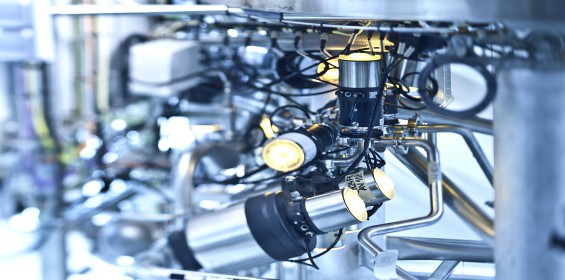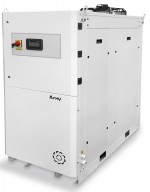Process control valves - making the right choice
Published: 23 April, 2020
Modern process control valves offer a wide range of features and benefits for industries that require precise control over fluids, steam and other gases. With so many control valves on the market, it is important to establish the features that will deliver the most cost-effective design for a particular application. Damien Moran, field segment manager, hygienic -pharmaceutical at Bürkert, looks at some of the basic differentiators as well as some recent design developments
Control valves are used to manage the flow rate of a liquid or a gas and in-turn control the temperature, pressure or liquid level within a process. As such, control valves are defined by the way in which they operate to control flow and include globe valves, angle seat, diaphragm, quarter-turn, knife and needle valves, to name a few. In most cases the valve bodies are made from metal; either brass, forged steel or in hygienic applications 316 stainless steel.
Establishing the parameters
Actuators use an on-board system that measures the position of the valve with varying degrees of accuracy, depending on the application. A contactless, digital encoder can place the valve in any of a thousand positions, making it very accurate, while more rudimentary measurements can be applied to less sensitive designs.
One of the main areas of debate when specifying control valves is determining the size of the valve required. Quite often process engineers will know the pipe diameter that is used in an application and it is tempting to take that as the defining characteristic for the control valve. Of greater importance are the flow conditions within the system as these will dictate the size of the orifice within the control valve. The pressure either side of the valve and the expected flow rate are essential pieces of information when deciding on the valve design.
Improving efficiency
Inside the valve body, the actuator design is predominantly either a piston or a diaphragm design. The piston design typically offers a smaller, more compact valve which is also lighter and easier to handle than the diaphragm designs. Actuators are usually made from stainless steel or polyphenolsulpide (PPS), which is a chemically resistant plastic. Theactuator is topped off by the control head or positioner.
Older, pneumatically operated positioners had a flapper / nozzle arrangement and operated on 3-15 psi, so no matter what the state of the valve, open closed or somewhere in between, the system was always expelling some compressed air to the atmosphere. Compressed air is an expensive commodity, requiring considerable energy to generate and when a manufacturing line is equipped with multiple process control valves all venting to the atmosphere, this can equate to a considerable waste of energy. It is important then to establish not only the most appropriate valve design, but also a cost-effective solution that takes account of annual running costs.
Modern, digital, electro-pneumatic valves that use micro solenoid valves to control the air in and out of the actuator have introduced significant improvements for operators. This design means that while the valve is fully open, fully closed or in a steady state, it is not consuming any air. This, and many other engineering improvements, have made substantial advances in both economy and precision.
Flexible designs
Valve seats can be interchangeable within a standard valve body, which allows the valve to fit existing pipework and the valve seat to the sized to the application more accurately. In some cases, this can be achieved after the valve has been installed, which would enable a process change to be accommodated without replacing the complete valve assembly.
Selecting the most appropriate seal materials is also an important step to ensure reliable operation; Steam processes would normally use metal-to-metal seals, whereas a process that included a sterilisation stage may require chemically resistant seals.
Having installed a new valve, setting it up is now comparatively easy and much less timeconsuming. In-built calibration procedures measure the air required to open and close the valve, the resistance of the piston seals on the valve stem and the response time of the valve itself. Once complete, the valve is ready for normal operation.
Improving safety
Control valves should be specified so that they operate in the 40-85% range so if the valve is commanded to a 10% setting, it can detect that something has potentially gone wrong with the control system and the best course of action is to close the valve completely. If the valve is commanded to a position of 10% or less this can cause very high fluid or gas velocities, which have damaging effects on the system and cause considerable noise and damage to the valve itself.
Modern control functionality can offer a solution that acts as a safety device to prevent damage to the process pipework and components. By building in a fail-safe mechanism, any valve position setting below a pre-set threshold will result in the valve closing completely, preventing damage to the surrounding system.
Control inputs can also include safety circuits to ensure safe operating conditions within the process equipment. For example, if an access panel on a vessel containing steam is opened, an interlock switch will open and the valve controlling the steam supply to the vessel can be closed automatically helping to mitigate any risks.
Improving reliability
Many process control environments offer less than ideal conditions for long-term reliability. Moisture-laden atmospheres, corrosive chemicals and regular wash-downs all have the capacity to shorten the service life of a process control valve. One of the potential weaknesses of the actuator is the spring chamber where atmospheric air is drawn in each time the valve operates.
One solution is to use clean, instrument air to replenish the spring chamber, preventing any contamination from entering. This offers a defence against the ingress of airborne contaminants by diverting a small amount of clean control air into the control head, maintaining a slight positive pressure, thus achieving a simple, innovative solution. This prevents corrosion of the internal elements and can make a significant improvement to reliability and longevity in certain operating conditions.
Ultimately, choosing the most appropriate process control valve can be a complex task that is often best achieved with the assistance of expert knowledge. Working directly with manufacturers or knowledgeable distributors enables process control systems to be optimised for long-term reliability as well as precision and efficiency.






 The UltraChill range of process chillers go from 0.89 to 160 kW. These compact, energy efficient units are suitable for a wide range of process cooling applications and industry sectors, including automotive, engineering, food and drinks production, pharmaceutical, plastics, print and packaging, medical and scientific.
The UltraChill range of process chillers go from 0.89 to 160 kW. These compact, energy efficient units are suitable for a wide range of process cooling applications and industry sectors, including automotive, engineering, food and drinks production, pharmaceutical, plastics, print and packaging, medical and scientific.
